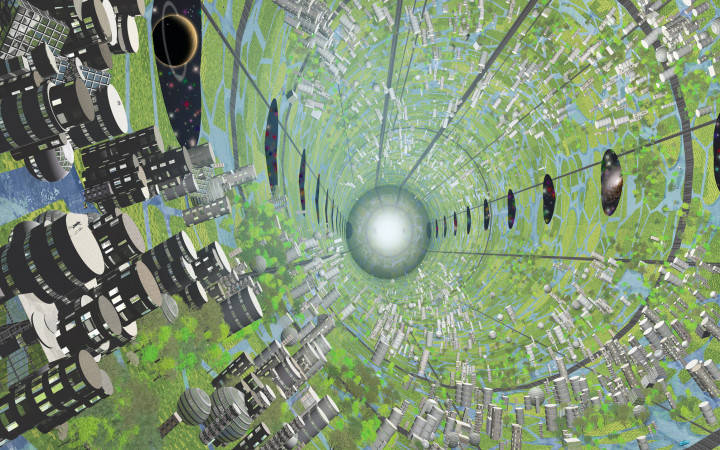Today’s Wonder of the Day was inspired by austin. austin Wonders, “can humans live in space” Thanks for WONDERing with us, austin!
It’s silent. It’s infinite. It’s mysterious. It may be a vacuum, but it certainly isn’t empty. That’s right—today, we’re setting our sights on outer space!
Have you ever dreamed about venturing into space? Most kids have. But where would you go? The Moon isn’t exactly habitable. Neither are Mars or Venus. In fact, humans would find it very difficult to live on any of the other planets in our solar system.
What if people could live in outer space . . . but not on another planetary surface? Over the years, many scientists have asked that same question. One of these was physicist Gerard O’Neill. His inquiry led to an idea that still fascinates many people today—O’Neill colonies.
What are O’Neill colonies? Picture spinning, steel cylinders that float in space. Their shape is why they’re also known as O’Neill cylinders. By spinning, these habitats would make artificial gravity. How? It’s similar to being on a merry-go-round. People inside the colonies would be pulled toward the interior surface by the constant motion.
What would life be like inside an O’Neill colony? People and animals would be able to move around the same way they do on Earth. The length of the cylinder would likely be divided into six sections. Three of these would be for land—where people would live and grow food. The other three would act as windows, allowing in light from the Sun. Of course, mirrors on the outside of the cylinder would deflect light at night. Darkness is important to human life, too!
The Sun would play an important role in life inside O’Neill colonies, just as it does for life on Earth. Each cylinder would be equipped with exterior solar panels. These would turn energy from the Sun into electricity to power the colony.
O’Neill first laid out his plan for space colonies in 1974. Since then, people have been fascinated by his idea. Similar space habitats have shown up in science fiction, such as Cooper Station in “Interstellar.” But will O’Neill colonies ever become a reality?
In 2019, Blue Origin founder Jeff Bezos shared his vision for O’Neill colonies and the future of life in space to benefit people on Earth. He believes these could someday house one trillion people in space. He envisions these habitats as ideal places to live, with perfect climates and beautiful architecture.
Living in an O’Neill colony, humans will find it easier to move around in outer space. That’s because they won’t be deep in Earth’s gravity. It’s like living on the ground floor of a building—you can walk right out on the street. Living on a planet is more like being on the 7th floor of a building with no elevator. It takes more time and effort to get outside.
Would every O’Neill colony be the same? Of course not! Bezos suggested that some might look like historical cities. Others could be enormous national parks or safe places for endangered species. Some could even be purely for recreation!
The pull of gravity wouldn’t even need to be the same in each colony. Bezos described the possibility of a colony with zero gravity, where people would be able to fly. Can you imagine going there for your next vacation?
Are you ready to move to an O’Neill colony? Don’t pack your bags just yet. These floating space habitats are still far in the future—and there’s much research still to be done. For example, how might growing up in an O’Neill colony impact the human body? The difference in gravity could have long-term effects.
However, the possibility is exciting for those who dream of living in space. As human technology continues to develop at a rapid pace, many can’t help but look at outer space as the last frontier.
Standards: NGSS.ESS1.A, NGSS.ESS1.B, CCRA.L.3, CCRA.L.6, CCRA.R.1, CCRA.R.2, CCRA.R.4, CCRA.R.10, CCRA.SL.1, CCRA.SL.2, CCRA.W.3, CCRA.L.1, CCRA.L.2




